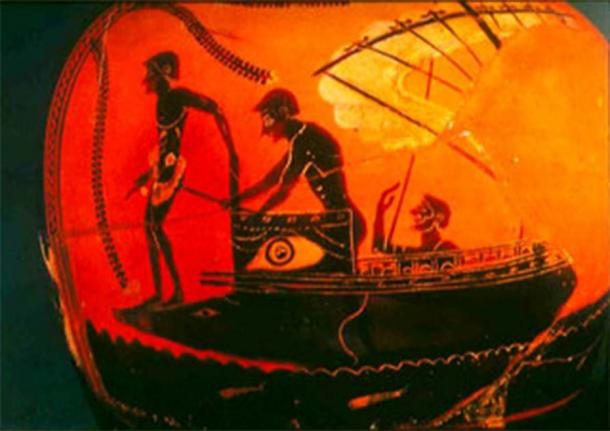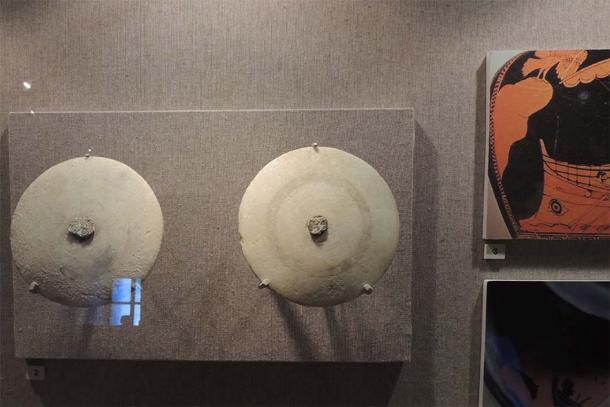
Israeli Swimmer Finds 2,500-Year-Old Magic Disc in the Mediterranean Sea
While taking his regular morning swim in the Mediterranean, an Israeli lifeguard named David Shalom spotted something unusual on the sea bottom in shallow waters. After diving down to take a closer look, he retrieved a smooth marble disc that resembled a small cymbal.
Recognizing the marble disc to be some kind of long-lost artifact, since there were many shipwrecks in the area in ancient times, the lifeguard turned the disc over to representatives of the Israel Antiquities Authority (IAA). Delighted to receive such an unusual object, these experts were able to identify the marble disc as a magic talisman that was designed to be hung on seagoing ships to protect them from evil spirits, witch’s spells or plain old bad luck.

A talisman, like the magic disc discovered off the coast of Israel, as depicted on ancient Greek pottery. (Israel Antiquities Authority)
The Magic Disc Was Once Used as a Talisman Against the Evil Eye
In an announcement on the Israel Antiquities Authority’s Facebook page on July 18, the experts reported that the marble disc is just under 2,500 years old, dating specifically to the fourth or fifth century BC.
“From drawings on pottery, mosaics, and ancient coins, as well as from historical sources from the 5th century BC, we learn that this design was common on ships’ bows and served to protect against the evil eye and envy, aided navigation, and acted as a pair of eyes looking ahead and warning of danger,” explained Yaakov Sharvit, Director of the IAA’s Marine Archaeology Unit. “This decoration is still common today on modern ships in Portugal, Malta, Greece, and the far east.”
- Rings, Gestures, and Phallus Talismans: The Evil Eye and Ancient Ways to Ward Off Its Power
- Is This Byzantine-Era Demon-Repellent Amulet Jewish or Gnostic?
David Shalom found the superbly crafted magic disc just offshore from the Yavne-Yam archaeological site near Palmachim Beach, 15 miles (24 kilometers) south of Tel Aviv. Yavne-Yam was a busy ancient port 2,500 years ago, and the site has produced a wealth of artifacts during both on-land and underwater explorations.
This particular marble disc can’t be linked to any particular shipwreck. But it’s safe to presume that the talisman came from a sunken vessel that wasn’t able to avoid a tragic outcome despite carrying its own good luck charm.

The magic disc was discovered just off the coast next to the archaeological site of Yavne-Yan near Tel Aviv, seen here. (Yitzhak Marmelstein / CC BY-SA 4.0)
The Magic Disc is a Truly Rare and Unusual Find
The sand-colored marble disc is approximately eight inches (20 centimeters) in diameter. It is perfectly round and flat on the underside and curved on the top side (hence its cymbal-like appearance). It has a hole drilled in its exact center and there are traces of two painted circles surrounding it, creating what experts identify as an eye motif.
Discs like these were attached to the bows of both warships and merchant vessels in ancient times. Crewmen would hammer lead or bronze nails through the central hole to mount it directly on the ship’s hull, and ships could then sail out into dangerous open seas knowing they were protected against evil forces of all types (or so they thought).
Given how common these magical discs were in the past, it would be expected that many of them would have been found in regions where shipwrecks were frequent. But up to now only four of these talismans have been recovered from the waters of the Mediterranean in total. This includes two fifth century BC relics that were found adjacent to a sunken merchant vessel during salvage operations at the Tektas Burnu site off the western coast of Turkey, and one that was found not far from the Yavne-Yam site at Israel’s Carmel Beach.
There is a suspicion that other such items may have been recovered over the years by amateur treasure hunters who chose to keep them or sell them on the black market instead of turning them over to heritage organizations, academic institutions or museums. Sharvit praised David Shalom for his honesty in not following this example. As a result of Shalom’s integrity, the IAA now has possession of a most rare ancient artifact.

Two stone magic discs discovered at the Tektas Burnu site off the coast of Turkey. Known as Ophthalmoi, they would have been affixed to the prow of a Greek ship to help it see underwater and avoid shipwrecks. They bear a striking resemblance to modern-day evil eye beads. (Anita Gould / CC BY-NC 2.0)
The Story of Yavne-Yam and its Archaeological Bounty
Based on decades of archaeological exploration, it appears Yavne-Yam was occupied and used for approximately 5,000 years. This has been revealed during excavations that took place on land and in the sea, with both locations producing a bounty of artifacts. “Yavne-Yam was settled for the first time in the Middle Bronze Age,” Sharvit said, “and was settled down to the Middle Ages. Near the ancient mound, there is a natural sheltered anchorage protected by a rock promontory.”
This means it was a good place for ships to anchor, and apparently a dangerous place to sail into given the number of shipwrecks that apparently occurred in the vicinity of Yavne in the distant past.
To learn more about maritime activity in Yavne-Yam harbor, the IAA’s Marine Archaeology Unit conducted a series of underwater dives in the region in the 1980s, and found an amazing collection of ruins and artifacts from several wrecked ships.
These vessels were clearly reserved for either merchant duty or for fishing. The artifacts recovered by the archaeologists included anchors of various sizes made from both stone and metal, fishing equipment and accessories of various types, a lead cooking oven, grinding stones, stone bowls, bronze arrowheads and a wide range of ceramic pottery including storage jars, bowls and cooking pots.
There were dozens of artifacts made from gold found during the explorations, including earrings, beads, ingots and fragments of assorted jewelry pieces. Two small statues depicting the Canaanite-Phoenician god Baal were also recovered, which like the gold pieces were dated to the Late Bronze Age.
- 11-Year-Old Boy Finds Rare Ancient Fertility Goddess Amulet In Israel
- The Mystical Arslan Tash Amulets: Protection From Night Demons
Careful analysis showed these items came from ships that sunk over the course of many centuries, starting with the Late Bronze Age but continuing through the Persian, Hellenistic, Roman and Byzantine periods. This covered a span of time ranging from the late second millennium BC to the Middle Ages.
“Many of the pottery vessels were manufactured in the Levant or the eastern Mediterranean, but some were imported from distant Mediterranean countries,” Sharvit said, noting the diverse origins of the underwater artifacts.
The sea trade at Yavne-Yam was obviously busy in ancient times, and many of the vessels that passed through were likely carrying marble discs meant to ward off evil. This was a tradition that lasted a long time, so many ancient sea captains must have believed the talismans really worked—which they clearly didn’t for the ships that sunk.
Top image: The magic disc was discovered by an Israeli lifeguard near Tel Aviv. Source: Israel Antiquities Authority
By Nathan Falde















